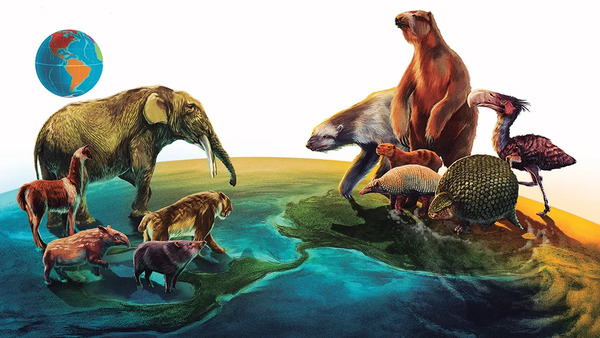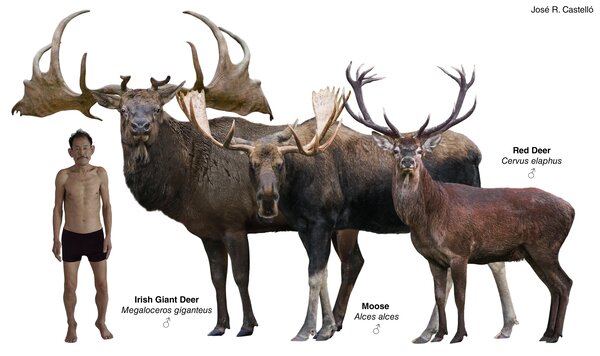Various species on Earth may become extinct for a variety of reasons, including climate change, food scarcity, reduced living space, or even major disasters such as asteroid collisions. Today we will discuss the ten most shocking extinct animals, they are Tyrannosaurus rex, mammoth, quagga, thylacine, Irish deer, Caspian tiger, European bison, auk, cave lion and dodo. Maybe you've heard of them before, they were all once unique on Earth but ceased to exist at different times and for different reasons.

1. Tyrannosaurus rex (extinct 65 million years ago)

Skeleton model of Tyrannosaurus "Sue" at the Field Museum of Natural History in Chicago, USA

Tyrannosaurus rex was at the top of the food chain in the late Cretaceous. At that time, almost all types of dinosaurs in North America were within its hunting range. Its body length is about 11.5 to 14.7 meters, the average height at the hip is about 4 meters, and the average weight is about 9 tons. It is considered to be one of the largest land carnivores in history. Tyrannosaurus rex was one of the last non-avian dinosaurs before the mass extinction event from the Cretaceous to the Tertiary period, and was also one of the last dinosaurs to become extinct.
2. Mammoth (extinct in 2000 BC)

The mammoth, commonly known as woolly mammoth or woolly mammoth, is an animal adapted to cold climates. It was once one of the largest elephant species in the world and one of the largest mammals that ever lived on land. Among them, the steppe mammoth weighed as much as Up to 12 tons. A giant of the Ice Age, they are similar in appearance to Asian Elephants-Are-Endangered.html">elephants, but look different due to their thick coat of hair. They were generally similar in size to modern African Elephants-Are-Endangered.html">elephants. With the extinction of the woolly mammoth, the Ice Age was gradually coming to an end, marking the end of that era.
3. Quagga (extinct in 1883)

The quagga, an animal that looks half zebra and half horse, hence its name, is one of Africa's best-known extinct animals. In fact, the quagga is a subspecies of the steppe zebra. Compared with other zebras, the quagga is unique in that it has obvious stripes on the front half of the body, but when reaching the middle part of the body, these stripes gradually fade and disappear, and the black area gradually expands, extending to the hind legs and buttocks, forming Totally brown area. This unique appearance makes the quagga unique in the animal kingdom.
4. Thylacine (extinct in 1936)

Considered the largest marsupial carnivore known today, the thylacine is native to Australia and New Guinea. In the twentieth century, the species was facing an endangered species and was often called the Tasmanian tiger, a name derived from the stripes on its back. At the same time, people are also accustomed to calling it the thylacine, or commonly known as the Tasmanian tiger or common tiger. The thylacine is arguably the only surviving subspecies of this species, and despite the existence of many related species, thylacine fossils are still discovered by humans. The origin of this species can be traced back to the early Miocene of the "Tertiary Period".
5. Irish giant deer (extinct about 7700 years ago)

The Irish giant deer, also known as the giant deer, was one of the largest deer species that ever existed on Earth. The recently discovered remains of the species date back to about 5700 BC, which is about 7700 years ago. The giant deer is famous for its majestic size (approximately 2.1 meters tall at the shoulder), especially its spectacular antlers, which are the largest of all known cervids (the maximum distance between antlers can reach approximately 3.65 meters) meters long and weighing up to 40 kg).
6. Caspian tiger (extinct in 1970)

The Caspian tiger, also known as the Persian tiger, ranks third among tigers and is one of the most widely known tiger subspecies. It was once distributed in Iran, Iraq, Afghanistan, Turkey, Mongolia and Russia (Central Asia, South Caucasus), and became extinct since the 1970s. This subspecies has a very compact body structure, thick and powerful legs, and unusually wide and huge claws. The ears are short, similar to a human without hair on the top of his head. The Caspian tiger's cheeks are covered with short hair, and the rest of the hair is long and thin. Its body color is very similar to that of the Bengal tiger. Male Caspian tigers are huge, weighing about 169 kg to 240 kg, while female Caspian tigers are smaller than males, weighing about 85 kg to 135 kg.
7. European bison (extinct in 1627)

The European aurochs is one of the famous extinct species in Europe. Like the ancient European aurochs (which is said to be the ancestor of modern domestic cattle), it is huge. European aurochs were introduced to India about 2 million years ago, then to the Middle East and Asia, and finally reintroduced to Europe 250,000 years ago. Until the 13th century, the distribution range of European bison was reduced to Poland, Lithuania, Moldova, Transylvania and East Prussia. The last surviving European female bison died in Poland's Jaktorów Forest Park in 1627. Its skull was collected by the Swiss Army and is now housed in the Stockholm Ordnance Museum.
8. Auk (extinct since 1844)

The great auk is a unique flightless species among the auks. It is huge and native to the Atlantic region. It has survived until modern times. However, sadly, the great auk has mysteriously disappeared. Often called petrels or penguins, it is about 75 centimeters tall and weighs about 5 kilograms. The flightless auk, the largest of the auk species, has a white belly covered with glossy black feathers on its back. Remains found in the midden area of Florida indicate that they flew south during the winter, continuing into the 14th century.
9. Cave lion (extinct 2000 years ago)

Known as the European cave lion or the Eurasian cave lion, the cave lion was once one of the largest lions on earth. In 1985, an adult male cave lion was discovered in Siegsdorf, Germany. He was about 1.2 meters tall and 2.1 meters long. He had no tail and was not much different from modern lions in size. The male lion was even larger than other specimens of the same subspecies, with the feline thought to be about 5 to 10 percent larger than modern lions. During the Wumu Ice Age about 10,000 years ago, cave lions were on the verge of extinction. However, there are still indications that this species existed in the Balkans until about 2000 years ago.
10. Dodo (extinct at the end of the 17th century)

The dodo is a flightless bird that inhabits the island of Mauritius and is closely related to the white pigeon and the dove. It is about 1 meter tall, feeds on fruits and lives on land. The dodo became extinct in the mid-to-late 17th century, becoming one of the typical representatives of extinct species, because its extinction process began in the period of human records. This tragedy is mainly attributed to human activities.

animal tags: extinct
We created this article in conjunction with AI technology, then made sure it was fact-checked and edited by a Animals Top editor.